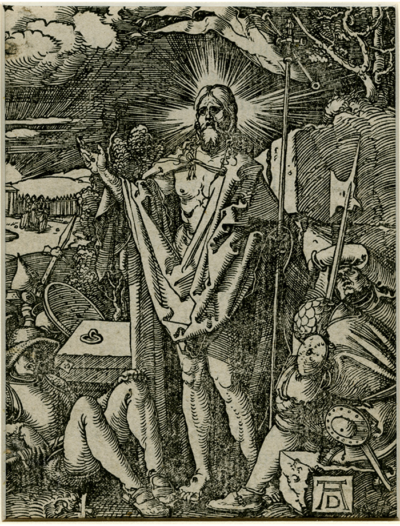La Salle University
Easter Reflection
Looking at the art:

The Small Passion: The Resurrection
1510
4 7/8 x 3 7/8 in. (12.4 x 9.8 cm)
Albrecht Dürer, German, (1471–1528)
Object Type: PRINTS
Creation Place: Europe
Medium and Support: Woodcut
Credit Line: Gift of Mr. & Mrs. Stuart Feld
Accession Number: 84-G-1300
Current Location: Art Museum : 15-16 C Gallery
Dominating this woodcut is the larger-than-life figure of Jesus risen from the dead, replete with his wounds visible and rays of light emanating from his head. Clearly the message is victory over death as Jesus holds in his left hand his victory staff with cross atop. “See, despite the suffering and crucifixion, death no longer has power over me!”
The entire woodcut is an amalgam of selected details recounted in the four gospels. Two lictors, stationed to guard the tomb, were so frightened by the earth trembling and the lightning like appearance of Jesus that they shook and were knocked down appearing to be dead. See those two men collapsed on either side of Jesus. The one shielding his eyes from the light with his arm is on the ground still holding his fasces, the ax-topped staff carried by Roman lictors. It looks like Jesus is standing tall with his own victory staff as a counterpoint to that guard collapsed in fear on the ground still brandishing his now useless fasces. The gospels report that women were on their way to the tomb with spices they had prepared. We see them in the clearing on the left in the background wondering, as Mark tells us, who was going to remove the stone from the entrance to the tomb. No worries! All four gospels are clear that the stone had already been removed and our woodcutter Albrecht Dürer has it prominently displayed lying there on the ground with its iron rings still attached. Triumphant over death and larger even than his own tomb, Jesus radiates hope for life and victory over oppression.
Reflection
The Resurrection, the first fruits of the victory that Jesus wins in his fight with the power of evil, is our hope for what awaits us. While all the gospels show the empty tomb as a witness that Jesus is no longer dead, only Matthew’s gospel mentions an earthquake and guard. Mark’s gospel, which we will read this year at the Easter Vigil, ends (at least the part that most scholars believe is the original ending) with this strange statement: They went out quickly and fled from the tomb, for they trembled and were amazed. And they said nothing to anyone, for they were afraid (Mark 18: 8, Modern English Version). They were afraid. I have never understood that. Jesus is risen, the one who was dead is alive. What is there not to be joyful about? Is it possible that they fear what they do not understand? Do they fear what is happening? They come to the tomb with spices expecting a body, wondering how they will gain access to that body. Who will roll away the stone? What they find instead is the stone rolled away, an empty tomb and a young man waiting for them. They are told by the young man that Jesus the Nazarene is risen and not here in this place of death; he is going before them to Galilee. Shock may be misunderstood as fear. In Mark’s gospel these women watch the crucifixion from a distance, and they see where he is buried without taking part in it, an implication that they have not fully accepted the mantle of discipleship. Is it possible that that first Easter morning they are afraid because they are finally beginning to understand what is being asked of them to be like Jesus? Resurrection, which they did not expect, comes only after the passage through death. Jesus, Son of God, could not avoid that passage. Remember that Mark wrote his gospel to a church that was carrying their crosses to their own crucifixions. They will not be able to avoid that passage. None of us as followers of the crucified will avoid that passage. Resurrection is our destination, but we need to walk the same road that Jesus walked to get there. Happy walking!